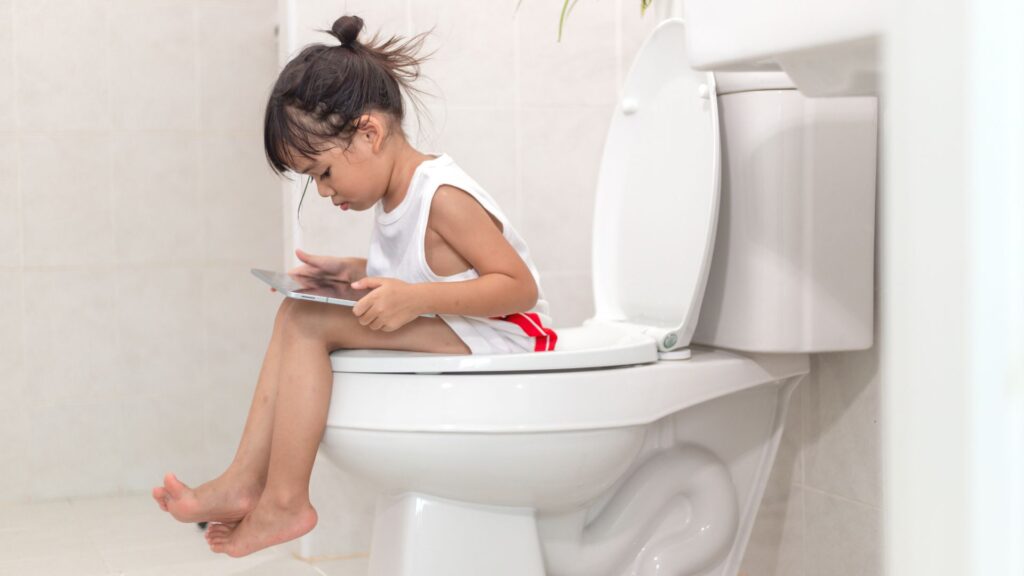My child is afraid to Poop – It’s not uncommon for a child to refuse to poop on the potty, even though peeing goes well. Some children wait until they’re wearing a sleep diaper, hide in a corner, or just go in their pants. This fear can stem from the worry of ‘losing something’ or the fear of pain, especially if the child has delayed pooping for a while and the stool has become harder. It can be tricky to figure out why your child refuses to poop on the potty, but there are ways to help.
1. Understand your child’s body
To start, it’s important to reassure your child and understand where the fear is coming from. First, ask them why they’re afraid. Explain to your child what’s happening in their body, so they gain more control and understanding of the pooping process. Understanding these situations can help your child better grasp the situation and feel more comfortable. For instance, explain how when they eat something, it goes into their stomach, then into their intestines, eventually becoming poop.
2. Use books as support
Reading books together with your child teaches them in a playful way about how the body works especially when your child is afraid to poop. These books are available in our webshop and can help your child understand their body. Additionally, many children also come to realize that they have control over their bodies and can take care of a pee or poop all by themselves – how cool is that!
3. Diet and bowel movements
Pay attention to your child’s diet during potty training and before and after. Adequate fiber-rich foods, such as fruits and whole grains, are important to prevent constipation. Try to encourage your child to use the potty or toilet after every meal to promote bowel movements. It’s also crucial not to start potty training if your child has a poop problem. This can lead to even more problems. So, make sure that your child’s pooping in the diaper goes well before you even start with this.
4. Pooping in stages
One of the most helpful tips when a child is afraid to poop. It’s important to reward every good step to keep your child motivated. And let your child really set the pace. If it takes too long and you see that your child is ready for the next step, approach it positively when you see that he or she is really ready for the next step. But make sure there is no pressure!
- Begin with wearing a nappy when your child indicates needing to use the toilet: Give your child a nappy when they indicate needing the toilet. Calmly explain that this is the first step and that it’s the same as a temporary sleep nappy, to make the transition gradual. If your child uses the nappy, then flush the poop together in the toilet. This will help your child get used to the idea that the toilet is the right place to poop. This way, your child also sees where the poop goes.
- Have your child sit on the toilet with a nappy when they need to poop: Once your child indicates they need to poop, place them on the toilet while they’re wearing a nappy. This gives your child the experience of sitting on the toilet while still having the familiar feeling of the nappy. Emphasize that it’s okay and reward this step again, even if they still poop in the nappy. It’s already super brave that your child dares to sit on the toilet!
- Create a small hole in the nappy: If your child feels comfortable on the toilet, try making a small opening in the nappy so that the poop can fall directly into the toilet. This is a step forward to get your child used to the idea of pooping without the full nappy, while still providing a sense of security and comfort. But the poop already goes directly into the toilet.
- Let the nappy hang at their ankles while your child sits on the toilet: Next, try allowing the nappy to hang loosely at your child’s ankles while they’re on the toilet. This gives your child more freedom and room for movement while still wearing the nappy. If this goes well, you can move on to the last step, which is without the nappy.
- Finally, encourage your child to poop on the toilet without a nappy: Once your child feels comfortable with the previous steps and has gained enough confidence to poop without a nappy, encourage them to do so. Praise and motivate your child to take this final step, but don’t force anything. It’s important to be patient and give your child the time they need to take this step.
Hopefully, these steps will help!
Is it still: “My child is afraid to poop?”
For children who regularly suffer from constipation, considering fiber-rich syrups may be helpful. These syrups can help soften the stool and promote regular bowel movements. Fiber-rich syrups are often aimed at stimulating the intestines, making passing stools easier. We recommend seeking advice from a doctor before giving specific products to your child.
If constipation with your child is an ongoing problem, your chilld is still afraid to poop and the use of fiber-rich syrups does not provide relief, it’s important to see if there is a medical reason that pooping is difficult. A doctor can assess the problem and provide certain advice or refer you to a special poop clinic at the hospital. Sometimes a doctor may prescribe special laxatives that are safe for children and can help regulate bowel movements, such as Macrogol.
We also regularly share tips about pooping on our social media channels like this post with poop tips.” If the poop problem is solved and your child is ready for potty training, you can start with our Potty Training Box.


